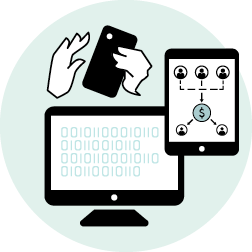So you want to start or expand an emerging markets business? Let's talk payment processing!
To be competitive you must offer your customers easy ways to pay for the products you sell. The catch? Because of the nature of your business, it can be tough for high-risk sellers to get a merchant account that allows for payment card processing. And you can’t accept payment by credit or debit card without a merchant account.
And while the ability to process card payments is table stakes in the world of selling goods and services these days, you’ll want to consider the range of capabilities a payment processor can offer you, and the cost structure, before you choose one to work with. Here are five capabilities to look for in a payment processor for your business.
1. Ability to process payments for businesses considered high-risk.
This may sound like a no-brainer, but you must find a payment processor backed by a sponsor bank that has specifically set a policy of approving emerging markets businesses. Historically, these businesses have fallen into a category of “high-risk” industries, and as such, they have struggled to secure a merchant account. Some processors, like MerchantE, have expanded their risk tolerance and established relationships with like-minded sponsor banks that may not accept all high-risk categories, but have now opened their services to accept this growing industry need.
2. Ease of integration with your website.
The last thing you want to do is retool your entire website to accept card payments. The time you spend doing so is time that could be spent on sourcing and selling products and running your operations. Instead, find a payment processor that offers options that make it manageable for you to enable card processing from your website. You will want options such as a link to a secure hosted payment page or a shopping cart so customers can self-pay.
3. A range of payment acceptance options.
Accepting payment transactions on your website or in a webstore goes a long way towards helping you grow your business, yet there are also other situations where commerce could be transacted. For example, a virtual terminal lets you accept payments over any internet-connected device, so you can input payments manually from anywhere, including phone or mail-in orders. You also may need your payment processor to support in-person transactions using point-of-sale (POS) devices for fast and secure in-store purchases.
Look for a payments provider who can offer expanded acceptance options so you can grow your business seamlessly without having to begin a search for a new provider as your business evolves. And as you explore your options, consider payment acceptance solutions that keep payment data secure and allow for contactless transactions, which are of growing importance amid today’s heightened health concerns.
4. End-to-end payment processing.
The payment processor is the critical link between a cardholder transaction and a merchant account. But as we outlined in a previous blog post, two kinds of processors are typically involved. Front-end processors are connected to various card associations and facilitate authorization of transactions to merchants. Back-end processors receive and then forward settlement funds to acquiring banks in a scheduled time frame.
End-to-end payment processors (including MerchantE) fulfill the entire range of front- and back-end functions. This offers two key advantages:
- An end-to-end processor has visibility into the entire process, which puts them in a better position to problem-solve when a merchant needs support (more on that issue below).
- One processor means fewer parties receive fees from every transaction, so the merchant can have fewer fees to pay.
While the opportunities for certain businesses to obtain a merchant account are expanding, they continue to be labeled in the high-risk category. As such, they can expect payment processing to cost more than for a low-risk business. Work with a reputable end-to-end processor if possible for the best chance of fair and consistent pricing.
5. Great customer support.
When it comes to payment processing, the support offered by your provider is always important, but maybe even more so for those in industries regarded as higher risk. Chargebacks and fraud concerns can be a major disruption to your business. To minimize the financial impact of both, fast and thorough responsiveness on the part of your payment processor is critical.
Ask any payment processors you’re evaluating about their hours of live support and how they handle disputes and fraud concerns. That way, you can assess whether they will partner with you to help minimize the impact of such issues and whether they have measures in place to prevent them in the first place. A single point of contact for end-to-end payment processing and the ability to talk live with people when needed are both important considerations.
Plan Today to Grow Even More Tomorrow
Some high-risk categories will still battle acceptance and regulation - but it's likely that will ease up over time as the industries continue to grow. High-risk sellers that have established a relationship with a payment processor and secured their online presence are going to be ahead of the game. Don’t let the “high risk” label discourage you from taking steps that will help your business grow today – and set the stage for even greater expansion tomorrow.
Discover how we're empowering merchants in sectors traditionally labeled as high-risk to do more with their money and grow their businesses faster!




